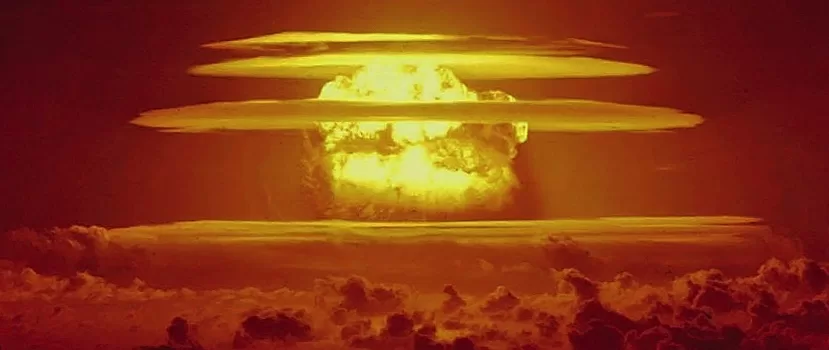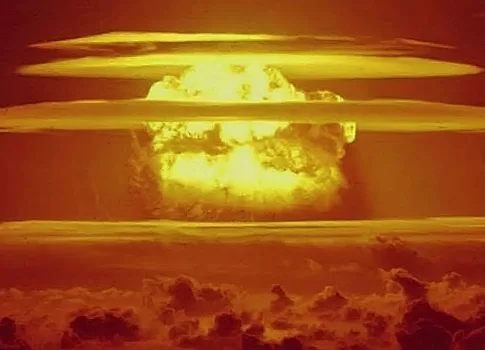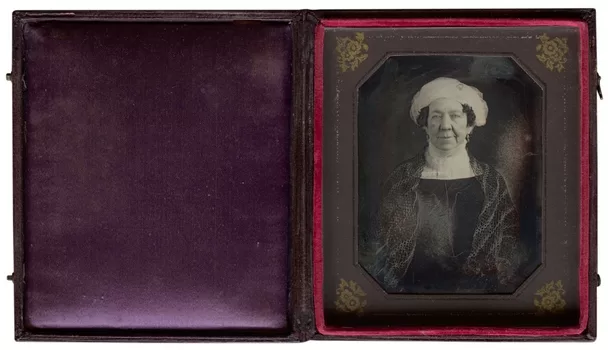The debate on USA nuclear testing has reignited with the proposal of Project 2025, a policy blueprint backed by the Heritage Foundation, which advocates for the resumption of nuclear testing under a potential second term of Donald Trump’s presidency.
The history of nuclear testing in the US is marked by technological advancements, strategic defense initiatives, and significant ethical dilemmas. From the first detonation in 1945 to the cessation of tests in 1992, these activities left a lasting impact on the environment and human health.
This essay explores the historical context of U.S. nuclear testing, the key points of Project 2025, and the controversies surrounding this proposed policy shift.
Our story on US nuclear testing continues after this advertisement:
The Controversy of U.S. Nuclear Testing: Past and Future Prospects
Historical Context of U.S. Nuclear Testing
The origins of U.S. nuclear testing trace back to the Manhattan Project during World War II, culminating in the Trinity test in New Mexico on July 16, 1945.
This marked the beginning of the nuclear age and led to the bombings of Hiroshima and Nagasaki. The subsequent Cold War era saw a rapid proliferation of tests, primarily at the Nevada Test Site (NTS), as the U.S. sought to maintain a strategic edge over the Soviet Union.
These tests included both atmospheric and underground detonations, such as the 1952 Operation Ivy hydrogen bomb test on Enewetak Atoll.
The environmental and health impacts of these tests were profound. Atmospheric tests released radioactive fallout that affected wide areas, including populated regions.
“Downwinders”
“Downwinders” – communities living downwind of test sites – experienced increased rates of cancer and other radiation-related illnesses.
Indigenous populations, such as the Western Shoshone in Nevada and the Marshallese in the Pacific, were particularly hard hit.
Over time, legal battles and government compensation programs, like the Radiation Exposure Compensation Act (RECA), sought to address these impacts, though many argue they remain insufficient.
Estimating the number of people who died as a result of U.S. nuclear testing is a complex task due to the indirect nature of many of these deaths.
The primary causes of death related to nuclear testing are long-term health effects from radiation exposure, such as cancer and other illnesses.
Here are some key points that provide insight into the scope of the issue:
Immediate Deaths
There were relatively few immediate deaths directly attributable to the nuclear tests themselves, as most tests were conducted in remote areas or under controlled conditions. However, there were some accidents and exposure incidents involving military and scientific personnel during the tests.
Long-term Health Effects
The long-term health effects of radiation exposure are more significant and widespread. Several studies and reports have attempted to estimate the number of deaths and health impacts from fallout:
Downwinders: Populations living downwind of test sites, particularly in Nevada, Utah, and Arizona, experienced higher rates of cancer and other radiation-related illnesses
The National Cancer Institute (NCI) has estimated that fallout from the Nevada Test Site alone might have caused thousands of cancer cases, particularly thyroid cancer, across the United States.
Global Fallout: Atmospheric nuclear tests released radioactive particles into the atmosphere, which dispersed globally.
A 2002 study published in the British Medical Journal estimated that global fallout from nuclear testing may have caused around 430,000 cancer deaths worldwide from 1951 to 2000.
Radiation Exposure Compensation Act (RECA): The U.S. government has acknowledged some of the health impacts through the RECA, which has compensated individuals who developed illnesses from radiation exposure due to nuclear tests.
As of 2020, RECA had awarded over $2.4 billion to more than 37,000 claimants.
Specific Estimates and Studies
National Research Council (NRC) Report (2005): This report estimated that fallout from U.S. atmospheric nuclear tests might have caused approximately 11,000 to 212,000 cancer cases in the United States, leading to roughly 6,000 to 12,000 deaths.
Institute for Energy and Environmental Research (IEER): The IEER has reported that radioactive fallout from atmospheric tests has caused significant health impacts, estimating tens of thousands of deaths worldwide due to cancers induced by exposure to fallout.
Indigenous Populations
Indigenous populations, particularly those near test sites like the Western Shoshone in Nevada and the Marshallese in the Pacific, were heavily impacted. The health effects in these communities have been severe, with elevated cancer rates and other illnesses.
Number of US deaths due to nuclear testing
While precise numbers are difficult to ascertain, it is clear that U.S. nuclear testing has resulted in tens of thousands of deaths over the decades due to radiation-induced cancers and other health issues.
The legacy of these tests continues to affect many communities, highlighting the need for continued research, support, and compensation for those impacted.
Project 2025 and Its Key Proposals
Project 2025 represents a significant shift in U.S. nuclear policy, emphasizing a return to nuclear testing and expansion of the arsenal. Key recommendations include:
Resumption of Testing:
The project advocates restarting underground nuclear tests to ensure the reliability and safety of the U.S. nuclear arsenal, a practice halted since 1992. This move aims to maintain superiority over adversaries like Russia and China (The Independent).
Modernization of Arsenal:
The proposal emphasizes updating the aging nuclear infrastructure and expanding the arsenal beyond current treaty limits, including the development of new nuclear-armed sea-launched cruise missiles (The Independent) (The Nation).
Strategic Shifts:
Project 2025 calls for a pivot away from diplomatic engagement towards military dominance. This includes restructuring the State Department, withdrawing from international organizations, and enhancing missile defense systems (The Nation).
Controversies and Criticisms
The proposal to resume nuclear testing has sparked significant controversy. Critics argue that renewed testing could provoke a global arms race, undermine international stability, and violate treaties like the Comprehensive Test Ban Treaty (CTBT).
Ernest Moniz, former Obama energy secretary, emphasized that new testing would make the U.S. less secure and could not be separated from its global consequences (The Independent).
The Arms Control Association also described the idea as “dangerous” and “counterproductive” (The Independent).
Furthermore, the broader implications of Project 2025’s military and diplomatic shifts raise ethical concerns. The focus on military expansion at the expense of diplomatic efforts and international cooperation reflects a strategy that many believe could lead to greater global instability.
Critics argue for a more balanced approach that prioritizes non-military tools of interaction, such as diplomacy, dialogue, and economic cooperation.
Make America Glow Again
The legacy of U.S. nuclear testing is a complex interplay of technological advancement, strategic defense, and ethical dilemmas.
Project 2025’s recommendations for resuming nuclear testing and expanding the arsenal represent a significant shift in U.S. policy, prioritizing military dominance at the potential cost of global stability and treaty obligations.
As debates continue, the implications of these policies will be closely scrutinized by both domestic and international communities, highlighting the need for careful consideration of the lessons learned from the past and the potential consequences for the future.

The History of U.S. Nuclear Testing
The history of nuclear testing in the United States is a complex and often controversial chapter in the nation’s pursuit of military and technological dominance.
Spanning from the early 1940s to the early 1990s, these tests were conducted to develop and perfect nuclear weapons, ensuring the United States maintained a strategic advantage during the Cold War.
However, the environmental, health, and social consequences of these tests have left a lasting impact, raising ethical questions and prompting calls for accountability and reparations.
Early Beginnings and the Manhattan Project
The origins of U.S. nuclear testing trace back to the Manhattan Project, a top-secret initiative during World War II aimed at developing the first atomic bomb.
The culmination of this project was the Trinity test on July 16, 1945, in the New Mexico desert. This test marked the first detonation of a nuclear device and ushered in the nuclear age.
The success of Trinity led to the bombings of Hiroshima and Nagasaki, which played a pivotal role in ending World War II but also demonstrated the devastating power of nuclear weapons.
The Cold War and the Proliferation of Tests
Following World War II, the United States entered into a protracted Cold War with the Soviet Union, characterized by an arms race to develop more advanced and powerful nuclear weapons.
The Nevada Test Site (NTS), established in 1951, became the primary location for U.S. nuclear tests. Over the next four decades, the NTS hosted hundreds of atmospheric and underground tests.
These tests were designed to improve bomb designs, understand the effects of nuclear explosions, and demonstrate military prowess.
One of the most significant tests during this period was Operation Ivy in 1952, which included the detonation of the first hydrogen bomb, “Mike,” on Enewetak Atoll in the Pacific.
The explosion was over 700 times more powerful than the bomb dropped on Hiroshima, highlighting the exponential increase in destructive capability.
Environmental and Health Impacts
While the strategic and scientific advancements were undeniable, the environmental and health impacts of nuclear testing were profound and often catastrophic.
Atmospheric tests, in particular, released significant amounts of radioactive fallout into the environment. This fallout was carried by winds and deposited over wide areas, including populated regions.
Communities downwind of test sites, known as “downwinders,” experienced increased rates of cancer, thyroid disorders, and other radiation-related illnesses.
Native American populations, particularly those in the Western United States, were disproportionately affected, as many tests were conducted on or near their lands without adequate warning or evacuation plans.
Legal and Ethical Controversies
The health impacts and environmental damage caused by nuclear testing have led to numerous legal battles and ethical debates.
In 1990, the U.S. government passed the Radiation Exposure Compensation Act (RECA), which provided financial compensation to individuals who developed health issues due to exposure from nuclear tests.
However, many argue that RECA is insufficient and that the government has not fully acknowledged or addressed the extent of the damage caused.
Ethically, the decision to conduct tests with known risks to human health and the environment raises questions about the balance between national security and the welfare of citizens.
The secrecy surrounding many tests, coupled with inadequate measures to protect affected populations, has led to a legacy of mistrust and calls for greater transparency and responsibility.
The Shift to Underground Testing and the Test Ban Treaties
In response to growing public concern and international pressure, the United States began to shift from atmospheric to underground testing in the early 1960s. This transition aimed to reduce the release of radioactive fallout.
The Limited Test Ban Treaty (LTBT) of 1963, signed by the United States, the Soviet Union, and the United Kingdom, prohibited nuclear tests in the atmosphere, outer space, and underwater, marking a significant step towards controlling nuclear proliferation.
Subsequent treaties, such as the Comprehensive Nuclear-Test-Ban Treaty (CTBT) of 1996, sought to end all nuclear tests.
Although the United States has not ratified the CTBT, it has observed a moratorium on nuclear testing since 1992.
The legacy of nuclear testing remains a critical consideration in contemporary discussions about nuclear disarmament and non-proliferation.
Further reading
Atomic Awakening: A New Look At The History And Future Of Nuclear Power Paperback, 2010 by James Mahaffey
Atomic Accidents Paperback, 2015 by James Mahaffey
The Making of the Atomic Bomb: 25th Anniversary Edition Paperback, 2012 by Richard Rhodes
Nuclear Reactor Analysis 1st Edition by James J. Duderstadt, Louis J. Hamilton
Related stories
Reactions to Dutton’s large nuclear reactor policy
Emissions wildly underestimated from fracking in NT
UN Secretary-General Calls for Fossil Fuel Advertising Ban
Global Methane Pledge: UN launch methane detection satellite
Net Zero+ International Programme for Action on Climate
Climate of the Nation Report: Australia Climate Research
Carbon Credits Used to Plug Orphan Oil & Gas Wells
Best way to reduce climate change is stop gas industry methane leaks
What is Greenwashing and How to spot it
Comments are open:




